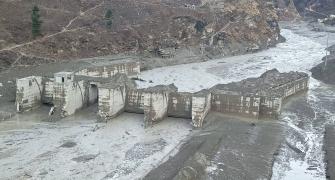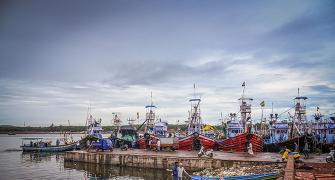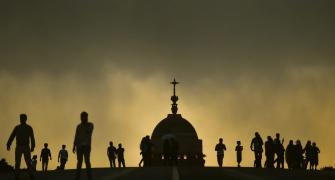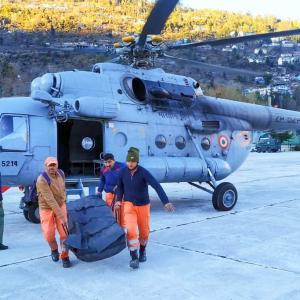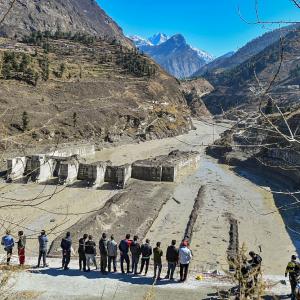'Events like the one we saw on Sunday are complex geological processes which can be impacted by weather and climatic conditions.'
'It is difficult to attribute something like this to just one factor or to a particular time period, especially when we have still not understood the exact cause.'

As climate change poses a major challenge as well as a threat in the Hindu Kush Himalaya region, Sunday's disaster in Chamoli in Uttarakhand has drawn worldwide attention.
As South Asia has about 40 per cent of the world's poorest people who will be most affected by the ramifications of climate change, it is an issue of concern for all.
With experts debating the reasons behind the incident, Dr Arun Bhakta Shrestha, who heads the transboundary river basins and cryosphere programme at the Kathmandu-based International Centre for Integrated Mountain Development, explains what may have occurred to Rediff.com Senior Contributor M I Khan. The ICIMOD works in eight South Asian countries: Afghanistan, Bangladesh, Bhutan, China, India, Myanmar, Nepal and Pakistan.

Even though it may be too early to say why the glacier broke off suddenly on Sunday, can you tell us the likely reasons behind it?
Yes, it is too early to say what exactly caused, and what the sequence of events was that led to the unfortunate incident in Uttarakhand on Sunday.
It will be important for scientists and experts to visit the field, collect the necessary data and also to obtain satellite imagery of the days leading up to Sunday to fully understand what happened.
There can be many possible scenarios, which we can already see being reported in the media -- from rockfall/landslides, slope failure, to avalanche, etc.
Any reason at this point in time would be speculation, so we will avoid commenting on this, until we understand it fully.

The glacier breach is also an opportunity for researchers and experts to study it. So will a team from ICIMOD undertake such a study?
I think first, let's not refer to the event as a 'glacier burst', as that phrase is unknown to the science community. We have yet to confirm if the incident had anything to do with a glacier, and if yes, to what extent.
As such, we do not plan on sending any independent team to the site at this point in time.

A politician in Uttarakhand has blamed the hot sun for the melting of the glacier on Sunday. Was the sun really hot on Sunday, is it a scientific explanation you think?
Events like the one we saw on Sunday are complex geological processes which can be impacted by weather and climatic conditions.
It is difficult to attribute something like this to just one factor or to a particular time period, especially when we have still not understood the exact cause of the flood.

But the fact is, it is hard to understand how the glacier melted in winter, and broke off.
Once again we have yet to confirm if this particular event has happened due to the melting of glaciers.
However, the glacier melting in itself is related to temperatures.
Usually we would not expect rapid melting in winter as the average temperatures tend to be colder than other periods.
What we do know and has been reported in our Hindu Kush Himalaya assessment report is that temperatures are rising faster in higher elevations in our mountains than in lower altitudes.
This has resulted in an increase in the melting of Himalayan glaciers.
We are likely to see the loss of between 1/3rd to 2/3rd of our glaciers in the Hindu Kush Himalaya region by 2100.
It is therefore important that the world come together and work to ensure that global temperature increase be kept to minimum.
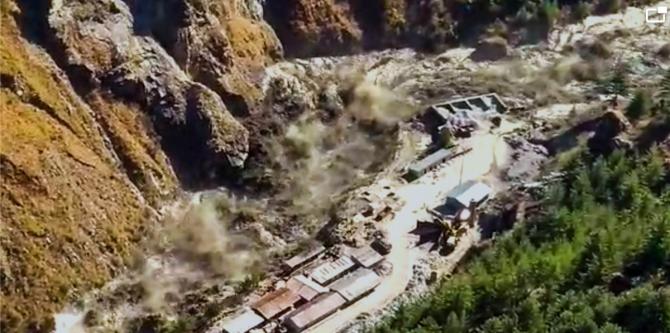
As an expert, did you expect such incidents in this part of the Himalayas? Should we take Chamoli as a warning sign?
Events like flash floods, glacial lake outburst floods, landslides, are natural events which we see periodically in the Hindu Kush Himalaya mountains and region.
However, what is worrying is with the impact of climate and socioeconomic changes in our mountains, there is a higher probability of such events happening more regularly and also in regions which have previously not experienced such events.
This could be disastrous for people and their livelihoods in downstream areas.
For this region it is critical that we focus and work on disaster preparedness and risk mitigation.
There are people talking about climate change being behind the Chamoli tragedy. Is there any study or data to support such a claim?
Until and unless we get all the data and fully understand what happened in Chamoli, it is not going to be possible to say anything with certainty.
Another challenge is that it is often difficult to attribute a single extreme event to climate change.
What we do know, and data supports this, is that climate change is having a significant impact on our mountain environments, which is worrisome.
This is worrying not just in terms of greater risk of disasters, but also in terms of the impact it will have on the ecosystems, water availability, agriculture, and livelihoods of millions of people who live in these mountains.

It has been reported time and again that glaciers are melting fast in the Himalayas. Is this a fact?
Yes, research and data have shown that glaciers are melting at an increasing rate in the Hindu Kush Himalayas.
This is related to the rising global temperatures and what we see is that the warming is higher in higher elevations.
To add to this, we are also seeing black carbon which is usually generated in the lowlands, from burning of fossil fuels, open agricultural and waste burning practices, being transported in the air and getting deposited on the glaciers.
This too has contributed to the accelerated melting of our glaciers.
At current rates, there is a high probability of us losing up to two-thirds of our glaciers by the end of this century.
Some experts say this tragedy was the result of increasing human intervention in the Himalayas.
The Hindu Kush Himalayas is a relatively young and fragile natural environment in geological terms.
As such they are not as stable as other mountain regions in the world like, for example, the Alps or the Rockies.
It is therefore important that human intervention in these environments be assessed and understood carefully before it happens.
Proper processes and due diligence are therefore of great value and important in mountain environments to avoid any unnecessary disasters.
Feature Presentation: Ashish Narsale/Rediff.com.


